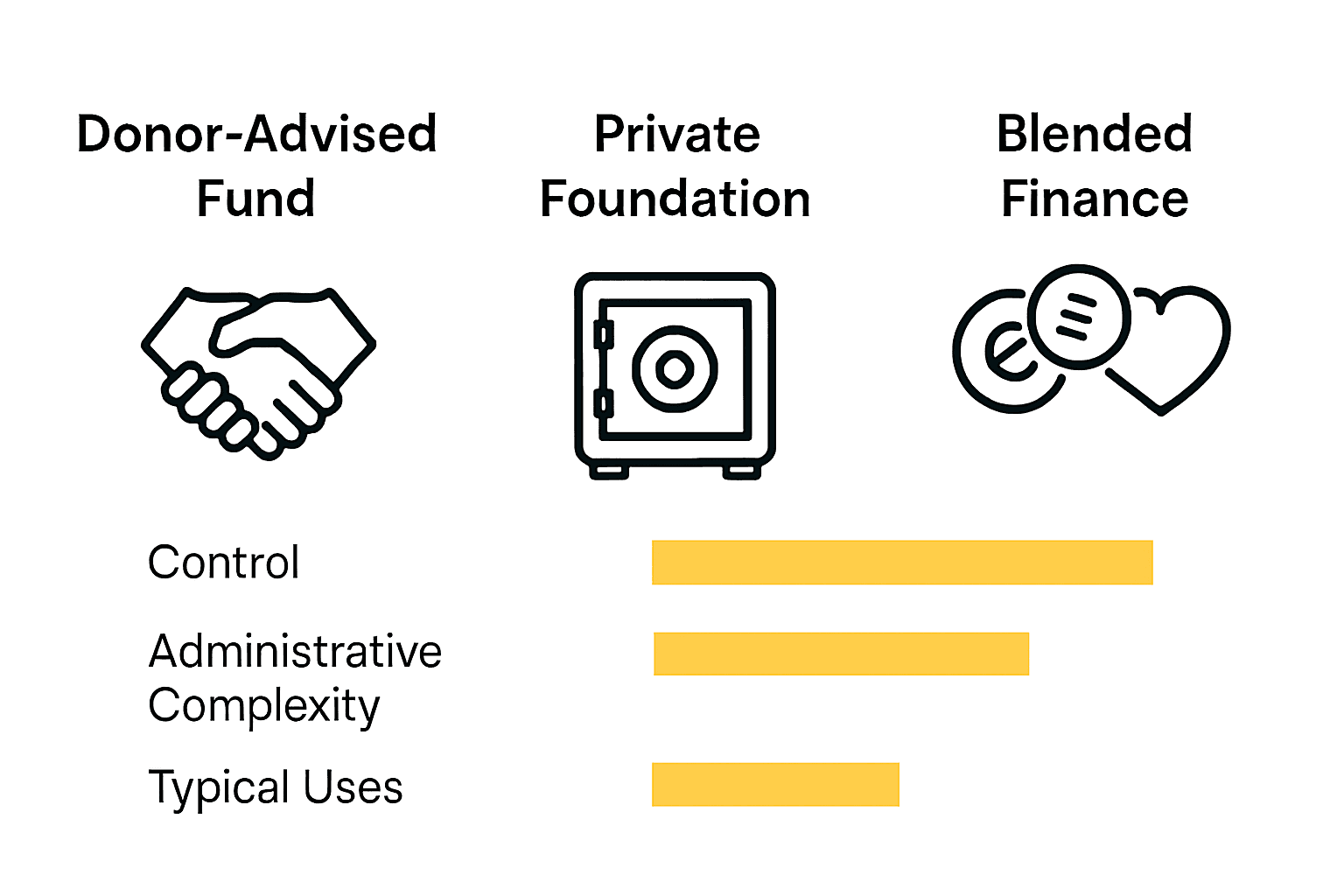Family offices are reshaping the future of giving, with over 86 percent now seeking measurable impact from their philanthropy. The traditional act of writing a check has evolved into a disciplined, data-driven strategy that blends purpose and performance. As family offices apply investment-style rigor to their charitable missions, they are creating long-lasting change that reflects both their values and financial expertise.
Key Takeaways
| Point | Details |
|---|---|
| Strategic Philanthropy | Family offices are increasingly adopting a strategic approach to philanthropy, integrating financial discipline with measurable social impact. |
| Diverse Philanthropic Vehicles | Family offices utilize varying philanthropic vehicles like donor-advised funds and private foundations to align their giving with strategic objectives. |
| Governance and Measurement | Effective governance and impact measurement are critical for successful philanthropic initiatives, requiring robust frameworks and ongoing evaluation. |
| Compliance and Adaptability | Navigating the legal landscape is essential; family offices must develop flexible compliance mechanisms to adapt to evolving regulations while maintaining their philanthropic goals. |
Table of Contents
- Defining Philanthropy In Family Offices
- Primary Models Of Family Office Philanthropy
- Establishing Governance And Giving Strategies
- Measuring Impact And Managing Outcomes
- Legal, Tax, And Compliance Considerations
- Common Pitfalls And Best Practice Insights
Defining Philanthropy in Family Offices
Philanthropy in family offices has evolved far beyond traditional charitable giving, transforming into a strategic approach that blends financial acumen with social impact. Blended finance now represents a sophisticated model where philanthropic capital is strategically deployed to generate measurable societal outcomes while maintaining potential financial returns.
According to research from the Bharat Economic Forum, modern family offices are pioneering a pay-per-outcome model that ties philanthropic disbursements directly to verified impact metrics. This approach enhances accountability and scalability by requiring tangible, measurable results from funded initiatives. Key characteristics of this strategic philanthropy include:
- Professional impact assessment teams
- Digital tracking and dashboard technologies
- Alignment with broader family values and operational strategies
- Direct connection to United Nations Sustainable Development Goals
As highlighted by Bespoke Impact Philanthropy, family offices are applying investment-style rigor to their charitable efforts. They meticulously vet potential projects, leverage advanced digital tools, and approach philanthropy as a professional discipline rather than a passive donation process. This shift represents a profound transformation from traditional checkbook philanthropy to an integrated, strategic approach that seeks to create meaningful, measurable social change while maintaining financial discipline.
Primary Models of Family Office Philanthropy
Family offices are increasingly sophisticated in their philanthropic strategies, moving well beyond traditional donation methods to implement nuanced, impact-driven approaches. Philanthropic vehicles have diversified, offering family offices multiple structures to align their charitable giving with strategic objectives and financial planning.
According to research from Star Legend Family Office, the primary philanthropic vehicles include:
Here’s a comparison of the primary family office philanthropic vehicles:
| Vehicle Type | Control Level | Administrative Complexity | Typical Uses |
|---|---|---|---|
| Donor-Advised Fund | Limited | Low | Agile giving Quick setup |
| Private Foundation | Maximum | High | Long-term strategy Custom programs |
| Charitable Trust/LLC | Moderate to High | Medium | Estate planning Cross-sector initiatives |
| Blended Finance Model | Variable | Variable | Outcome-linked giving Investment + social impact |
- Donor-Advised Funds (DAFs): Quick to establish, low administrative burden, but with limited control
- Private Foundations: Provide maximum control with more complex regulatory requirements
- Charitable Trusts and LLCs: Offer flexibility, particularly useful for estate planning and cross-sector impact initiatives
As highlighted by the Bharat Economic Forum, many progressive family offices are now adopting blended finance models that combine grant funding with investment capital. These innovative approaches link philanthropic payouts directly to achieved outcomes, creating a more dynamic and accountable giving strategy. By implementing pay-per-outcome frameworks, family offices can not only maximize social impact but also attract additional private investors interested in measurable, sustainable change.

Interestingly, many sophisticated family offices are now creating dual structures – maintaining a private foundation for long-term strategic philanthropy while simultaneously utilizing donor-advised funds for more agile, immediate giving opportunities. This hybrid approach allows for comprehensive, flexible philanthropic engagement that can adapt to evolving social needs and investment landscapes.

Establishing Governance and Giving Strategies
Creating a robust philanthropic framework requires deliberate planning and strategic infrastructure. Governance in family office philanthropy goes far beyond simple charitable disbursements, transforming into a comprehensive approach that integrates family values, operational expertise, and measurable social impact.
According to research from Star Legend Family Office, effective philanthropic governance involves several critical components:
- Establishing a clear philanthropic mission statement
- Defining precise focus areas and grant criteria
- Creating formal boards or advisory councils
- Engaging next-generation family members through dedicated committees
- Integrating philanthropy into the broader family office operational infrastructure
Successful family offices recognize that governance is not a static process but a dynamic, evolving strategy. This means developing flexible frameworks that can adapt to changing social needs, emerging impact opportunities, and the shifting priorities of family members across generations. The most effective philanthropic strategies create structured decision-making processes that balance professional rigor with family values and emotional connection.
Moreover, sophisticated family offices are now treating philanthropic governance as a professional discipline. This involves implementing robust tracking mechanisms, developing clear performance metrics, and approaching charitable initiatives with the same strategic discipline applied to investment portfolios. By creating transparent, accountable governance structures, family offices can maximize their social impact while maintaining financial discipline and preserving the family’s long-term philanthropic legacy.
Measuring Impact and Managing Outcomes
Measuring philanthropic impact represents a critical evolution in family office charitable strategies, transforming giving from a passive activity to a data-driven, strategic discipline. Impact measurement has become a sophisticated process that demands the same rigor and analytical approach family offices apply to their investment portfolios.
According to Wealth Briefing’s survey, a striking reality emerges: while 86% of family offices recognize the importance of measuring philanthropic impact, only half are actually implementing comprehensive measurement frameworks. This gap highlights the emerging opportunity for more strategic philanthropy. As highlighted by Bespoke Impact Philanthropy, successful family offices deploy multiple tools to track and evaluate their charitable investments:
- Professional impact assessment teams
- Comprehensive risk management frameworks
- Detailed due diligence processes
- Compliance monitoring systems
- Digital grant management software
- Sophisticated impact tracking dashboards
The most advanced family offices are treating philanthropic investments with the same analytical scrutiny as their financial portfolios. This means developing clear, measurable key performance indicators, establishing baseline metrics before funding initiatives, and creating ongoing evaluation mechanisms that track both quantitative and qualitative outcomes. By implementing robust measurement strategies, family offices can ensure their charitable efforts create genuine, verifiable social impact while maintaining financial accountability.
Ultimately, impact measurement is not just about proving effectiveness—it’s about continuous learning and improvement. Sophisticated family offices view these metrics as dynamic feedback loops that help refine their strategies, optimize resource allocation, and create more meaningful, sustainable social change.
Legal, Tax, and Compliance Considerations
Navigating the complex landscape of legal, tax, and compliance requirements is a critical challenge for family office philanthropic strategies. Regulatory frameworks surrounding charitable giving are intricate, demanding sophisticated understanding and proactive management to ensure both legal compliance and strategic effectiveness.
According to research from Star Legend Family Office, selecting the appropriate philanthropic vehicle is a nuanced decision that depends on multiple factors:
- Tax timing considerations
- Estate planning objectives
- Desired level of organizational control
- Regulatory compliance requirements
- Flexibility of structure
The Financial Times highlights an important emerging trend: while family offices often benefit from regulatory exemptions and potential tax advantages, they are simultaneously facing increased global scrutiny. This evolving landscape means philanthropic teams must develop robust compliance mechanisms that can adapt to changing regulatory environments. Potential benefits include deducting management fees and salaries, but these advantages come with heightened responsibilities for transparent financial reporting and risk management.
Sophisticated family offices are increasingly adopting dual structures to balance administrative complexity with strategic flexibility. By combining different philanthropic vehicles like donor-advised funds, private foundations, and charitable trusts, they can optimize tax efficiency, maintain operational agility, and create comprehensive giving strategies that align with both financial planning and social impact objectives. The key is developing a dynamic compliance approach that anticipates regulatory changes while maintaining the family’s philanthropic vision and operational integrity.
Common Pitfalls and Best Practice Insights
Philanthropic success in family offices requires strategic foresight and a nuanced understanding of potential challenges. Organizational design plays a critical role in determining whether philanthropic efforts will thrive or falter, with many families encountering predictable obstacles that can derail their most well-intentioned initiatives.
According to Fund Front’s research, family offices frequently encounter several common pitfalls in their philanthropic strategies:
- Lacking a comprehensive governance framework
- Over-hiring full-time staff
- Combining asset-holding with operational functions
- Maintaining excessive banking relationships
- Under-utilizing technology solutions
- Creating overly complex organizational structures
Family Office HQ highlights that the most successful philanthropic efforts focus on strategic adaptability and multi-generational engagement. Best practices include collaborating with other philanthropic entities, adopting systems thinking for long-term change, and creating meaningful leadership opportunities for younger family members. These approaches transform philanthropy from a transactional activity into a dynamic, purpose-driven ecosystem that can evolve with changing social landscapes and family priorities.
Ultimately, the most effective family office philanthropic strategies maintain a delicate balance between professional rigor and emotional connection. By creating lean, purpose-aligned designs that prioritize impact over complexity, families can develop philanthropic approaches that are both strategically sound and personally meaningful. The key is remaining flexible, continuously learning, and maintaining a clear vision that transcends individual projects and resonates across generations.
Take Your Family Office Philanthropy to a New Level
Family office philanthropy is evolving quickly. The article highlights how critical it is to move past basic donations and instead focus on robust governance, outcome-driven giving, and professional impact measurement. If you are struggling to establish a comprehensive framework or feel overwhelmed by the administrative, legal, or compliance challenges involved, you are not alone. Many family offices face roadblocks such as measuring true impact, aligning strategies with family values, and adapting to new blended finance models. These challenges require more than just expertise—they demand the right connections, resources, and partnerships.

Ready to transform your approach? Join Future Family Office, the online hub designed for the next generation of philanthropy and wealth management. Discover tailored resources, connect with experts, and access professional directories to help your family office implement smarter, more effective philanthropy. Register today at https://futurefamilyoffice.net to access exclusive content, list your family office, and accelerate your journey toward measurable social impact. Do not wait—now is the time to give your strategic philanthropy the platform it deserves.
Frequently Asked Questions
What is the role of philanthropy in family offices?
Philanthropy in family offices involves strategic charitable giving that combines financial discipline with social impact, moving beyond traditional donation methods to focus on measurable outcomes.
How do family offices measure the impact of their philanthropic efforts?
Family offices use various tools such as professional impact assessment teams, digital tracking technologies, and performance metrics to evaluate the effectiveness and social impact of their charitable initiatives.
What are the primary philanthropic vehicles used by family offices?
The main philanthropic vehicles include donor-advised funds (DAFs), private foundations, charitable trusts, and blended finance models, each offering different levels of control and complexity in administration.
What are some best practices for governance in family office philanthropy?
Effective governance practices include establishing a clear mission statement, defining focus areas, creating advisory councils, engaging the next generation, and integrating philanthropy into the family office’s overall operational framework.




